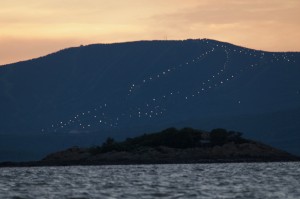 The storms passed through without too much problem, and our anchor held us through the 15-foot rise and fall of the tides overnight as we overlooked the ski hill of Mont-Sainte-Anne. As Great Lakes sailors we never have to concern ourselves with tides and currents. This stretch of the River has forced us to take a crash course in this new dimension of cruising.
The storms passed through without too much problem, and our anchor held us through the 15-foot rise and fall of the tides overnight as we overlooked the ski hill of Mont-Sainte-Anne. As Great Lakes sailors we never have to concern ourselves with tides and currents. This stretch of the River has forced us to take a crash course in this new dimension of cruising.
The next morning we realized we’d missed our ebb-tide window to reach our next planned stop, so we scanned our books, charts and guides and found something about 12 miles away.
 As we approached our area we sailed a narrow passage between a few islands, one of which turned out to be the Grosse Île Quarantine Station. Apparently immigrants, mostly from Ireland, were funnelled through this station from 1832 to 1937 as a means of controlling cholera and smallpox. It now operates as a living museum.
As we approached our area we sailed a narrow passage between a few islands, one of which turned out to be the Grosse Île Quarantine Station. Apparently immigrants, mostly from Ireland, were funnelled through this station from 1832 to 1937 as a means of controlling cholera and smallpox. It now operates as a living museum.
When we arrived at our intended stop we quickly concluded the currents were way too strong to anchor there. But sharp eyed Annnneeeeeeeeee noticed another spot on the chart so we dropped there for the night. While there we watched a bunch of local boaters sail/motor over to a shallow area, and anchor in high tide. Then we watched as the tide went out, and the boats were left high and dry. This included sailboats with their keels left stuck in the mud. Amazing, and kinda scary.
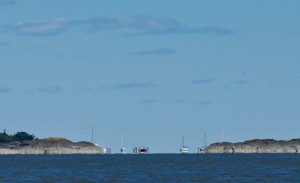
The next day was a long sail to our next possible anchorage at Isle-aux-Coudres across from Baie Saint-Paul. Ian Tamblyn, whom we saw live in Belleville a few days before leaving, has a wonderful song called Tiger Lily Road. It traces a summer spent in the area we are now travelling. Needless to say, Ann was all a-swoon as we passed and sighted the various locations named in the song:
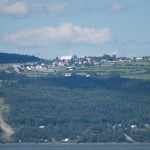
- Baie St. Paul
- Les Eboulements
- Mal Baie
- Tadoussac
- Saguenay
- Saint Rose
- Les Escoumins
It was a 60+ nm day, but by catching the early morning ebb tide we were able to travel at around 2 to 3 knots of additional speed. This is a lot for our little boat that usually averages around 5 knots. We’ve been averaging around 7 to 8 knots these days!!
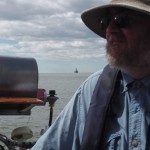
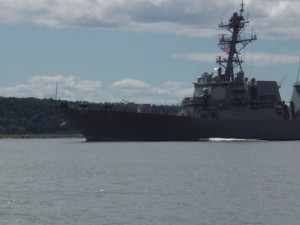 As we approached Isle-aux-Coudres around noon a couple of warships (one American and one Canadian) that were docked in Quebec City finally caught up to us. The American one gave me a blast from the horn when it decided to try and run us over by turning directly into our path!
As we approached Isle-aux-Coudres around noon a couple of warships (one American and one Canadian) that were docked in Quebec City finally caught up to us. The American one gave me a blast from the horn when it decided to try and run us over by turning directly into our path!
We anchored off the island in about 10 feet of water and 1 knot of current. Later this turned into about 30 feet or water and currents just shy of 4 knots!!! That’s a lot of current. It’s like being in a rushing river. There was little sleep that night as I listened to every scrape and groan of our anchor, fearing it would rip out of the ground and send us hurling into the island.
Later that same day we were also overtaken by the fleet of tall ships that had left Quebec City. We had front row seats to the best tall ship show in town, including watching the Bluenose II under full sail!
We did hold through the night … and held good. The next morning it took us about an hour to bring up all the anchor and chain. The anchor had buried itself so deep in the sand that I was afraid we were going to have to abandon it. But we got it up and headed off again.
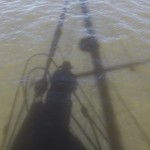 This part of our journey has been completely dictated by tides and currents. We leave with the ebb tide, which produces an ebb current in our favour. These tidal currents are normally around 2 to 3 knots, which means we can barely make ground when the current turns against us (the flood current). This means leaving with the ebb tide, and stopping when slack turns to flood. The ebb tides have all been starting very early in the morning, which means WE start very early in the morning. The nice thing is the flood starts by early afternoon, so we have to be settled around noon. Short, but fast days…
This part of our journey has been completely dictated by tides and currents. We leave with the ebb tide, which produces an ebb current in our favour. These tidal currents are normally around 2 to 3 knots, which means we can barely make ground when the current turns against us (the flood current). This means leaving with the ebb tide, and stopping when slack turns to flood. The ebb tides have all been starting very early in the morning, which means WE start very early in the morning. The nice thing is the flood starts by early afternoon, so we have to be settled around noon. Short, but fast days…
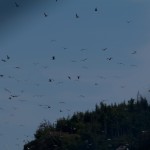 Checking the charts we found a likely spot about 16 nm south of the Saguenay Fjord off an island in the middle of the river named Iles du Pot à l’Eau-de-vie. Pot of the water of life … sounds wonderfully poetic. And it was. We dropped the hook as close to the small islands as we dared, and watched the birds fly and play all day.
Checking the charts we found a likely spot about 16 nm south of the Saguenay Fjord off an island in the middle of the river named Iles du Pot à l’Eau-de-vie. Pot of the water of life … sounds wonderfully poetic. And it was. We dropped the hook as close to the small islands as we dared, and watched the birds fly and play all day.
A few hours after anchoring we noticed the same trimaran which had anchored near us off Isle-aux-Coudres come motoring up and anchor nearby. We waved at the couple at the helm, and then noticed, one, two, three and then four small heads appear on deck. Turns out this cute young family from Quebec City was on their first real cruise with their new (to them) boat. The kids were from about eight to three … quite the adventure.
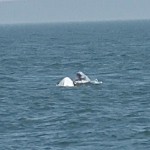 The next day we hauled up anchor and headed to the famed Saguenay Fjord, a national park and environmental treasure along these waters. The first few hours under sail went great. We even saw our first beluga whales! But as we neared the mouth of the fjord I (who was on the helm) began getting navigationally confused. I kept pointing across the river to our destination, but all my chart plotters kept telling me we were going in the opposite direction — DIRECTLY TOWARDS AN ISLAND!!!!
The next day we hauled up anchor and headed to the famed Saguenay Fjord, a national park and environmental treasure along these waters. The first few hours under sail went great. We even saw our first beluga whales! But as we neared the mouth of the fjord I (who was on the helm) began getting navigationally confused. I kept pointing across the river to our destination, but all my chart plotters kept telling me we were going in the opposite direction — DIRECTLY TOWARDS AN ISLAND!!!!
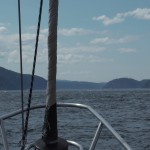 Turns out there are these vicious currents called rips that ramp up to 7 knots or more. We were caught in one of them, and no matter what direction I went, we could get no where. The only way forward was to go the long way around the island, and then come back up using the island as a current shadow. We motored for hours to break through, but finally did, only to meet some of the dreaded Saguenay outflow current, swirling whirlpools and large standing waves right at the mouth of the fjord.
Turns out there are these vicious currents called rips that ramp up to 7 knots or more. We were caught in one of them, and no matter what direction I went, we could get no where. The only way forward was to go the long way around the island, and then come back up using the island as a current shadow. We motored for hours to break through, but finally did, only to meet some of the dreaded Saguenay outflow current, swirling whirlpools and large standing waves right at the mouth of the fjord.
If not for the courage of the fearless crew, the Minnow, (er… the Pachina Mia), would be lost 😉 . But we got through and made our way up this ecological wonderland. The first thing we noticed was the blast of warm air that hit us as we entered the valley going past Tadoussac. The air on the St. Lawrence had been quite frigid during our sail, but the fjord was funnelling warm air from the land. It was beautiful.
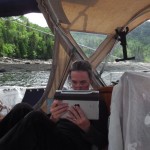
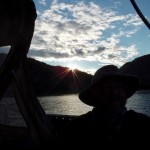 We made our way up the valley to one of the likely anchorages and dropped the hook. It was tricky due to 15 foot tides, strong currents, and steep drop offs that went from 30 feet to 200 feet. We found a spot and spend the next three days relaxing and reading, and watching whales and seals and loons and other various birds as they lived around us.
We made our way up the valley to one of the likely anchorages and dropped the hook. It was tricky due to 15 foot tides, strong currents, and steep drop offs that went from 30 feet to 200 feet. We found a spot and spend the next three days relaxing and reading, and watching whales and seals and loons and other various birds as they lived around us.
After a few days we had to move on. We watched a few more belugas cruise by as we headed out the mouth and back into the St. Lawrence, on to the next steps in our journey towards Terre Neuve.
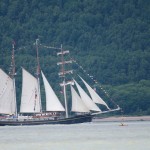
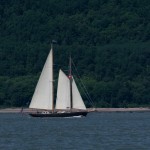
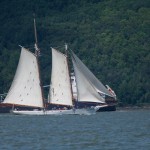

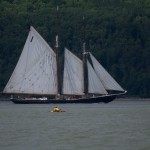
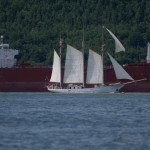
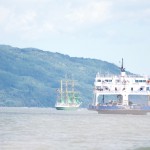


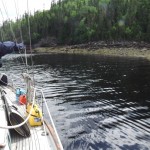
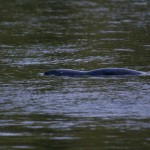
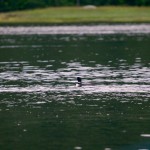

Ile-aux-Coudres, Baie St. Paul, Les Eboulements, La Mal Baie, Tadoussac, Les Escoumins… all places close to my heart! Your journey is quite exciting to read about from my stationary computer chair… So glad to read how far along you’ve made it, when we compare the current under the brige of the Thousand Islands and the standing waves of the Saguenay River!!!
Yeah, those currents under the bridge are nothing compared to what we’ve learned to deal with. And the tides! Anchoring in 20+ feet of tidal range is now old hat. It’s actually getting easier now that we’re further downstream. Tides are only in the 6-8 foot range now, and currents mostly run around 1-2 knots.
This is beautiful country — very much like Lake Superior. We’ve come this far only to find our way home 😉
🙂
🙂 😉 🙂
Oh boy, you guys sound so amazingly calm and capable in the midst of exciting and stressful situations. (Even taking the author’s editorial prerogative into account.)
Nice to hear you’ll likely get a bit of an easier sail for awhile.
Love the pic of Mt Ste Anne in the summer night!
Thanks for the update.
Challenging sailing and navigating, eh? I often tried to imagine the early explorers trying to deal with the extremes of the St. Lawrence River as I dealt with similar situations 20 years ago!
No kidding! It’s hard enough with all the modern conveniences of tide tables and current maps. Can’t imagine hitting this stuff completely cold.
The tides add a whole new dimension to our sailing and cruising. Anchoring means adding 15 to 20 feet to the rode calculation. And the planning required to ensure we run with the flow through the entire day’s sail is taxing my mathematical skills at times. But I think we’re through the hardest parts now. From here on down it’s currents in the 1-3 knot range, and tides in the 5 to 10 foot size — piece of cake!
Great to see the big boats. The tides sure kept you busy.
Yes, it’s a whole new world here in the the land of tides and currents. Looks like we’re through the largest of these though now.